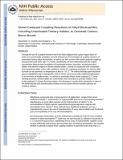Nickel-Catalyzed Coupling Reactions of Alkyl Electrophiles, Including Unactivated Tertiary Halides, To Generate Carbon–Boron Bonds
Author(s)
Dudnik, Alexander S.; Fu, Gregory C.
DownloadFu_Nickel-catalyzed coupling.pdf (2.177Mb)
PUBLISHER_POLICY
Publisher Policy
Article is made available in accordance with the publisher's policy and may be subject to US copyright law. Please refer to the publisher's site for terms of use.
Terms of use
Metadata
Show full item recordAbstract
Through the use of a catalyst formed in situ from NiBr[subscript 2]·diglyme and a pybox ligand (both of which are commercially available), we have achieved our first examples of coupling reactions of unactivated tertiary alkyl electrophiles, as well as our first success with nickel-catalyzed couplings that generate bonds other than C–C bonds. Specifically, we have determined that this catalyst accomplishes Miyaura-type borylations of unactivated tertiary, secondary, and primary alkyl halides with diboron reagents to furnish alkylboronates, a family of compounds with substantial (and expanding) utility, under mild conditions; indeed, the umpolung borylation of a tertiary alkyl bromide can be achieved at a temperature as low as −10 °C. The method exhibits good functional-group compatibility and is regiospecific, both of which can be issues with traditional approaches to the synthesis of alkylboronates. In contrast to seemingly related nickel-catalyzed C–C bond-forming processes, tertiary halides are more reactive than secondary or primary halides in this nickel-catalyzed C–B bond-forming reaction; this divergence is particularly noteworthy in view of the likelihood that both transformations follow an inner-sphere electron-transfer pathway for oxidative addition.
Date issued
2012-06Department
Massachusetts Institute of Technology. Department of ChemistryJournal
Journal of the American Chemical Society
Publisher
American Chemical Society (ACS)
Citation
Dudnik, Alexander S., and Gregory C. Fu. “Nickel-Catalyzed Coupling Reactions of Alkyl Electrophiles, Including Unactivated Tertiary Halides, To Generate Carbon–Boron Bonds.” Journal of the American Chemical Society 134, no. 25 (June 27, 2012): 10693-10697.
Version: Author's final manuscript
ISSN
0002-7863
1520-5126